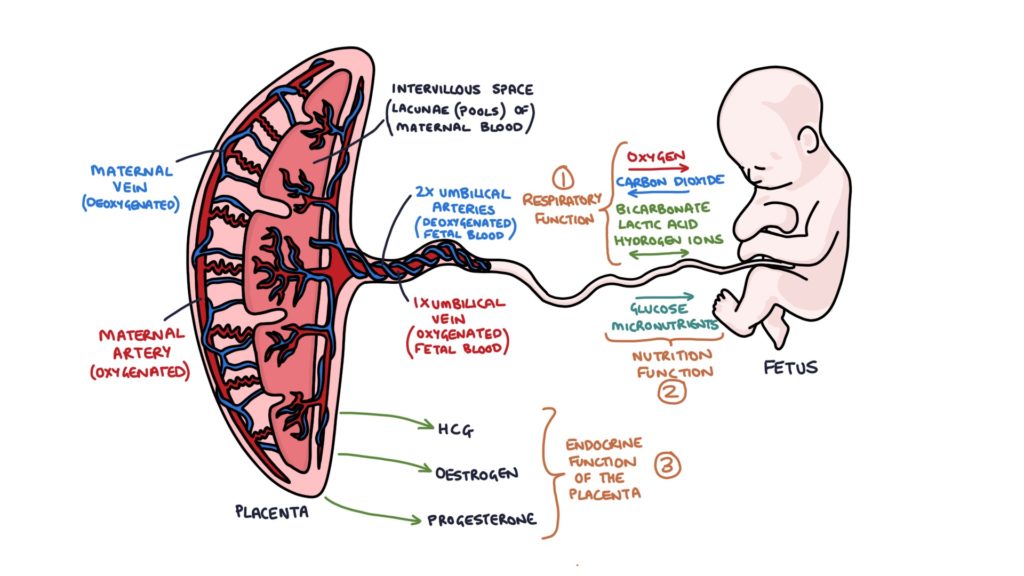Respiration
The placenta is the only source of oxygen for the fetus. Fetal haemoglobin has a higher affinity for oxygen than adult haemoglobin. The fetal haemoglobin is more attractive to oxygen molecules than the maternal haemoglobin. As a result, when maternal blood and fetal blood are nearby in the placenta, oxygen is drawn off the maternal haemoglobin, across the placental membrane, onto the fetal haemoglobin. Carbon dioxide, hydrogen ions, bicarbonate and lactic acid are also exchanged in the placenta, allowing the fetus to maintain a healthy acid-base balance.
Nutrition
All of the nutrition for the fetus comes from the mother. This nutrition is mostly in the form of glucose, which is used for energy and growth. The placenta can also transfer vitamins and minerals to the fetus, as well as potentially harmful substances if the mother is consuming medications, alcohol, caffeine or cigarette smoke.
Excretion
The placenta performs a similar function to kidneys in a child or adult, filtering waste products from the fetus. These waste products include urea and creatinine.
Endocrine
Human Chorionic Gonadotrophin
The syncytiotrophoblast produces hCG. hCG levels increase in early pregnancy, plateau at around ten weeks gestation, then start to fall. HCG helps to maintain the corpus luteum until the placenta can take over the production of oestrogen and progesterone. HCG can cause symptoms of nausea and vomiting in early pregnancy. Higher levels of hCG occur with multiple pregnancy (e.g. twins) and molar pregnancy. Pregnancy tests look for hCG as a marker of pregnancy.
Oestrogen
The placenta produces oestrogen, which helps to soften tissues and make them more flexible. Oestrogen allows the muscles and ligaments of the uterus and pelvis to expand, and the cervix to become soft and ready for birth. It also enlarges and prepares the breasts and nipples for breastfeeding.
Progesterone
The placenta mostly takes over the production of progesterone by five weeks gestation. The role of progesterone is to maintain the pregnancy. It causes relaxation of the uterine muscles (preventing contraction and labour) and maintains the endometrium. It causes side effects by relaxing other muscles, such as the lower oesophageal sphincter (causing heartburn), the bowel (causing constipation) and the blood vessels (causing hypotension, headaches and skin flushing). It also raises the body temperature between 0.5 and 1 degree Celsius.
Immunity
The mother’s antibodies can transfer across the placenta to the fetus during pregnancy. These antibodies allow the fetus to benefit from the long term immunity of the mother during the pregnancy and shortly after birth. An example of this is with recurrent genital herpes, where the mother’s antibodies to the herpes virus cross the placenta and protect the baby during labour and delivery, preventing infection during birth. This protection does not occur during an initial episode of genital herpes, as the mother has not yet started producing sufficient antibodies against the herpes virus to offer the fetus protection.
Last updated May 2020

